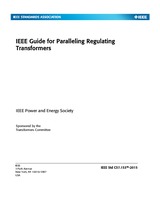We need your consent to use the individual data so that you can see information about your interests, among other things. Click "OK" to give your consent.

IEEE C57.153-2015
IEEE Guide for Paralleling Regulating Transformers
STANDARD published on 30.4.2015
The information about the standard:
Designation standards: IEEE C57.153-2015
Publication date standards: 30.4.2015
SKU: NS-586532
The number of pages: 107
Approximate weight : 352 g (0.78 lbs)
Country: International technical standard
Category: Technical standards IEEE
Annotation of standard text IEEE C57.153-2015 :
New IEEE Standard - Active.
Control methods of paralleling regulating transformers are described and compared in this guide. The control methods include: master/follower, circulating current, power factor,
circulating reactive current and negative reactance methods. Operating philosophy descriptions, sample wiring diagrams, typical operational variations, the provision of adequate backup protection, and typical misapplication consequences are presented. This guide does not apply to phase-shifting regulating transformers
ISBN: 978-0-7381-9640-4, 978-0-7381-9641-1
Number of Pages: 107
Product Code: STD20176, STDPD20176
Keywords: backup protection, circulating current method, circulating reactive current method, IEEE C57.153(TM), line current compensation, line drop compensation, master/follower method, negative reactance method, power factor method, tap changer control, transformer loading, transformer paralleling, voltage control
Category: Transformers
We recommend:
Updating of laws
Do you want to be sure about the validity of used regulations?
We offer you a solution so that you could use valid and updated legislative regulations.
Would you like to get more information? Look at this page.



 Cookies
Cookies
